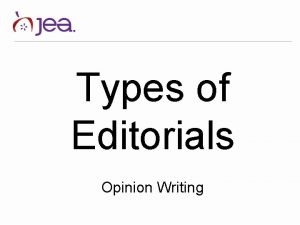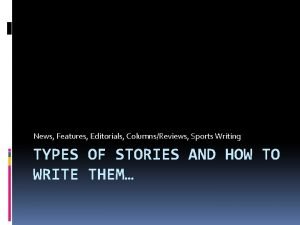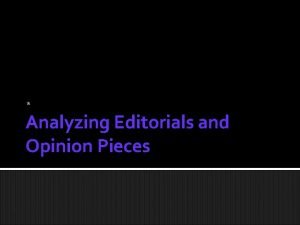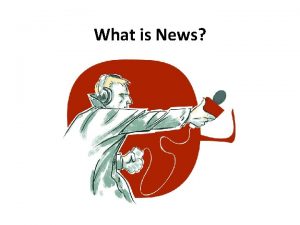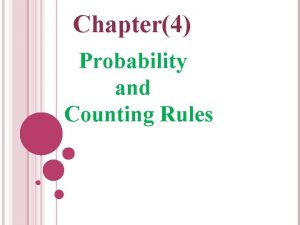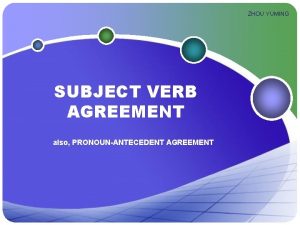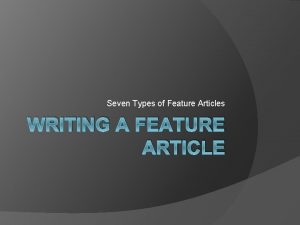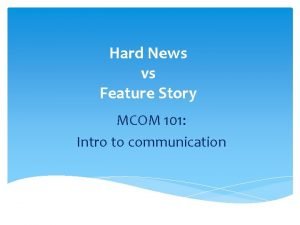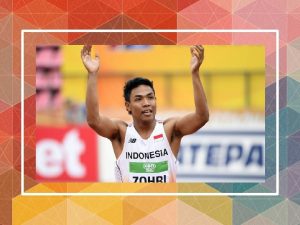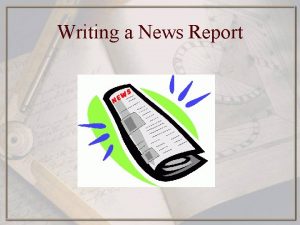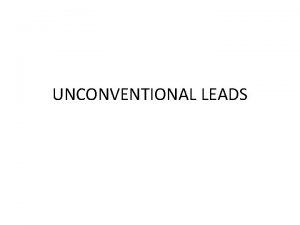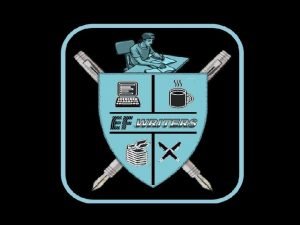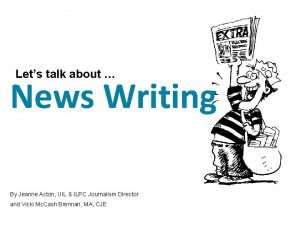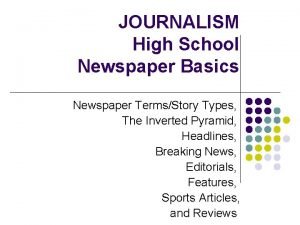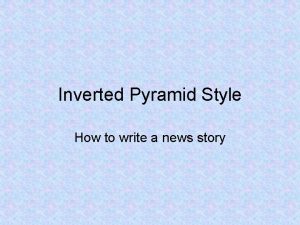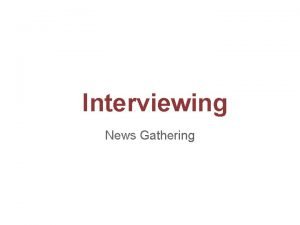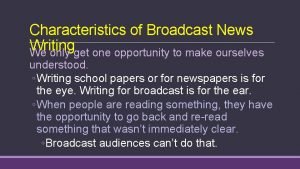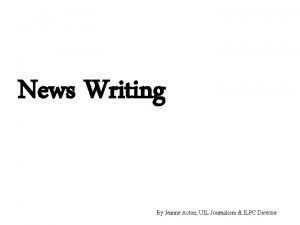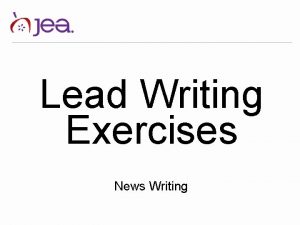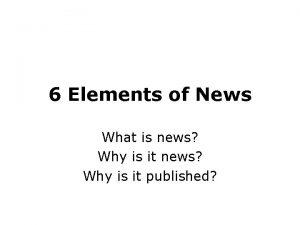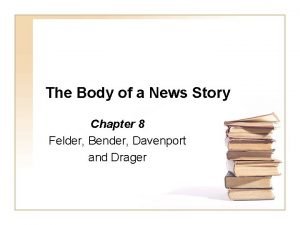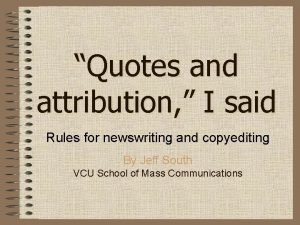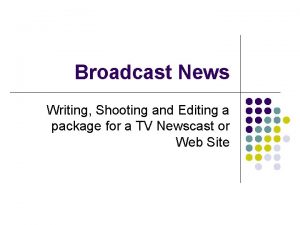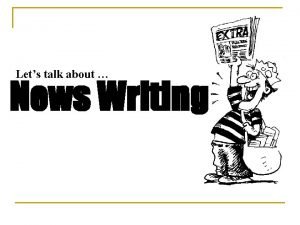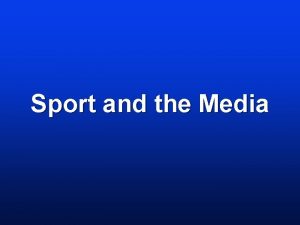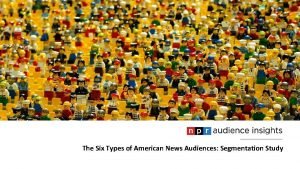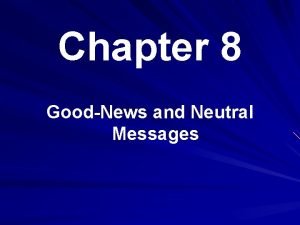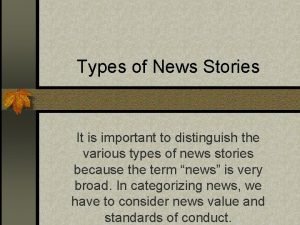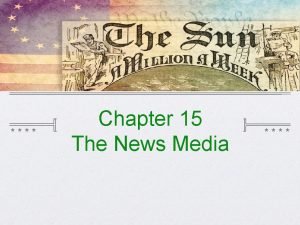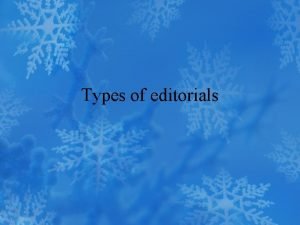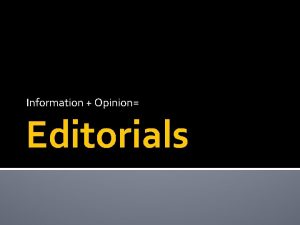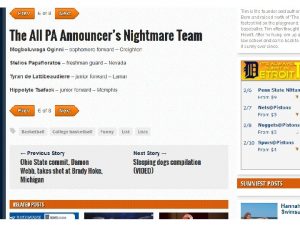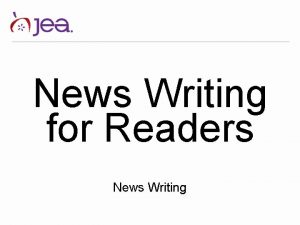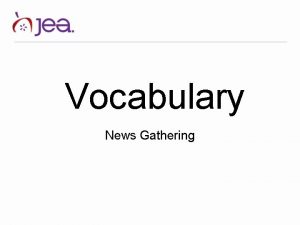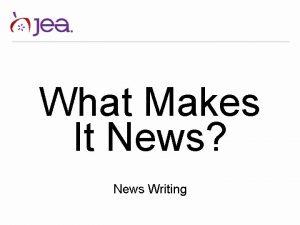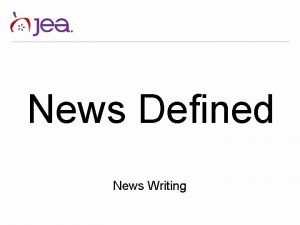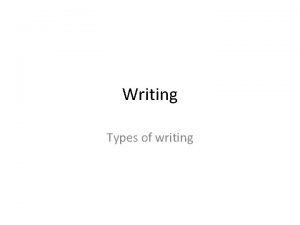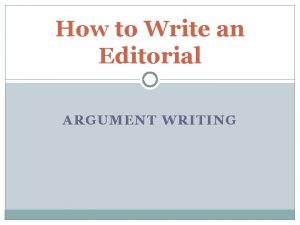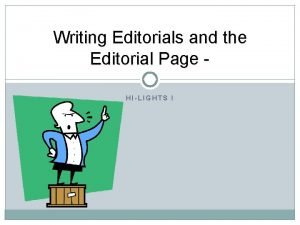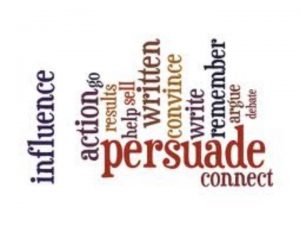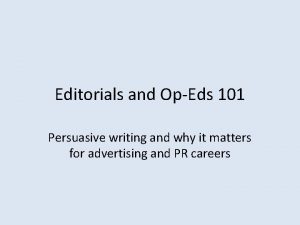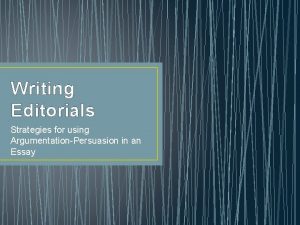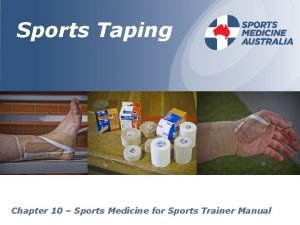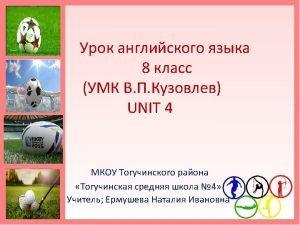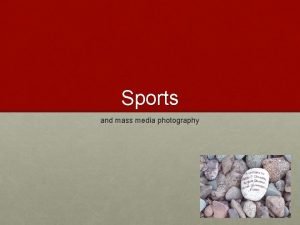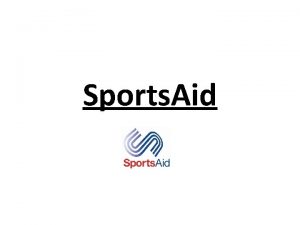News Features Editorials ColumnsReviews Sports Writing TYPES OF





































- Slides: 37

News, Features, Editorials, Columns/Reviews, Sports Writing TYPES OF STORIES AND HOW TO WRITE THEM…

News Stories How to write a LEAD And in the INVERTED PYRAMID STYLE

Getting to the Heart of it When writing a News story you must first decide what the main point of the story is. Ask yourself, “So what? ” or “What’s this about? ” or “What’s my point? ” while considering the information to gather. Once you have identified your main point, you can consider what approach to take to the overall story. Is it a serious story, or hard news? Or is it soft news? Does it need a direct lead or indirect lead? Will you follow the traditional inverted pyramid story organization?

Writing your Lead The lead is the opening of any piece of journalistic writing. Except for the headline, the lead is the writer’s only chance to hook the reader into continuing with the story. Readers spend about three seconds deciding whether to stay with one story or skip to another.

Types of Leads Direct News Lead: This is known as a summary lead. This is also known as an AP summary lead since the Associated Press stresses it. A direct or summary lead consists of one or two-sentence opening paragraph that contains the most important elements in a news story and does not exceed about 35 words. Important elements in a story are the 5 w’s and 1 H. These are the time-honored journalistic questions: Who? What? When? Where? Why? And How?

Direct News Lead Continued A smooth flowing lead probably cannot incorporate all 6 ideas, so the writer must decided what is the most important one to emphasize by placing it first and which others to include in the opening paragraph. The others can be used later in the story, perhaps as early as the second paragraph.

Impact Lead An impact lead starts to answer the “So What? ” question. It makes absolutely clear what effect this news event will have on the reader.

Quote Lead The quote lead does exactly what it says: starts the story with a compelling quote that sums up its main point. Compelling quote leads are rare. In news stories, journalists can get the main points across better than a quote.

Question Lead The question lead is simply a lead paragraph phrased as a question. Like the quote lead, these leads do not give the reader solid information about the story, so it’s better to avoid them most of the time.

Indirect Lead Today journalists are not limited to using the direct or summary lead to begin their news stories. Creativity has become increasingly important to newspaper journalists as consumers get their immediate news from 24 -hour services. The indirect lead, or soft lead, draws the reader into the story in some way other than directly with a summary of the facts. Because it delays the facts it is sometimes known as a feature lead, or a delayed lead.

Indirect Lead Continued Before it gets to the specifics of a news event, it may –set a scene, introduce a character, introduce a situation, or relate a story to an anecdote. Leads that relate a story are known as storytelling leads. A teaser lead is an opening paragraph containing a one sentence reference to something in the story that will pique the reader’s interest.

Homework Print off or cut out 2 newspaper articles that are NEWS STORIES. Highlight the leads and identify the type of lead. We will share and read them in class tomorrow.

How to write FEATURES

Feature Writing Feature writers have more flexibility, and they are allotted more creativity than hard-news reporters. However, accuracy and objectivity still applies. Feature writing is: Interesting-worth reading on its own merit. Well researched and reported. Professional-journalistic rules for language and style apply.

Types of Features News Feature: Hard-news stories often lend themselves to related feature stories. Example: Hard News=the deployment of troops for military action. Following Feature=how the mobilization will affect the families of soldiers, what the soldiers can expect to experience, what type of training do they go through.

Types of Features Profiles and Human Interest Features Because people are inherently interested in the lives of those around them, one of the most popular features is the profile. A profile typically focuses on someone who has made a notable impact on the lives of others, someone from the community, or simply someone with a unique talent or hobby.

Types of Features Personal experience and Accomplishment Feature. These stories address many subjects, from injuries and adversity to personal triumphs and professional awards. Example: Journalists have chronicled their travels to exotic places and written about the experiences and how it changed them.

Types of Features Informative Features Informative features can focus on many subjects, from the latest in high school crime rates to identifying the best economy car to purchase. The key is research!

Opinions/Editorials EDITORIAL WRITING

Editorials The opinions of journalists are usually presented on a single editorial page. Three common types of editorials are: Interpretation Criticism and persuasion Entertainment

Types of Editorials Interpretation: taking a complex topic, breaking it down and crafting a coherent editorial. List the arguments in your article in some way. Clearly identify your main points. Formulate your opinion on the issue. Criticism and Persuasion: These articles generate emotion because they take a pro/con stance. The editorial is trying to persuade a reader on a sensitive issue. Entertainment: Using humor or numbers or lists to get your opinion across. This method mainly entertains your reader (Letterman’s top ten list).

How to write COLUMNS AND REVIEWS

Columns and Reviews Columns: In hard news, the reporter is simply providing of facts and quotes from news sources. In a column, the writer’s opinion, along with supportive facts, forms the story. Columnists develop a following among fellow students, and often students may approach you with story ideas. Good columnists know what is going on around the school.

Types of Columns Humorous columns: using sharp wit and appropriate humor is a good tool for making an impact, but think seriously about your subject and how it will be perceived. Personal/Interpretive columns: this is how you observe and interpret life at school from the perspective of in insightful writer. Lifestyle columns: these columns specialize in pop culture. Topics range from fashion to TV.

What makes a column interesting? A column should be written to attract a broad crosssection of readers. Columnists must come up with ideas that are unique and appealing, entertaining and insightful. In most columns the tone is conversational, as though the writer and reader were chatting over a cup of coffee. Try to relate to your readers by sharing their concerns and interests. After reading a well done column, the reader should leave knowing something they didn’t know before.

Reviews On the most basic level, reviews are opinions. A good review not only describes content, but also goes a step further and provides a thoughtful analysis of the subject matter. Types of reviews we might include: Film, Book, Albums.

Things to consider when Reviewing Movies/Films: what did the film do to inspire you? How effective were the dialogue and script? Did the central characters develop throughout the film? Were the actors immersed in their roles or did they appear to “walk through” the film? How were the transitions? What about the cinematography---how visually appealing was the film? Did the film contain unnecessary violence or other content? Was the film’s length appropriate? Was the plot original? Did the musical score enhance the power or drama of the film? Was it a sequel? How did it compare to the first? Did it have artistic merit, or did it seem made primarily to showcase a major actor or actress to generate profit?

Album Reviews Here are some questions to ask when reviewing an album: How is the overall sound? How are the transitions from one song to the next? How many songs are on the CD? Does it show originality and distinctiveness? What about song lyrics—are they funny, silly, relevant, uplifting, poetic, profound? Is it better or worse than previous work? How does it fit within the genre? Has the band made any personnel changes? How do they compare to other bands in the genre?

Book Reviews Here are some questions to ask when reviewing a book: Is the writing clear and concise? Is the writing modest or does it draw attention to itself, thereby making it difficult for the reader to comprehend? Does the book move logically from chapter to chapter? Are the characters well developed? Are the factual assertions documented? Is the author credible? Is the concept original? Is the topic important enough to keep the reader interested? On the whole is it worth reading?

How to achieve SPORTS WRITING

Sports Writing Sports can be covered chronologically in three stages, beginning with a preview of an event or game to come, coverage of the game or event, and follow-up analysis. Besides coverage of events, news, features, and opinion pieces shape sports pages.

The Preview/Advance Story Preview or advance stories get fans excited about the upcoming event. The key to a good preview article is excellent backgrounding. This means that you, the reporter, talk to coaches from both teams and talk to some of the players. Do research and check statistics from the athletic office, check data from previous papers.

The Game Story Backgrounding helps a sportswriter tremendously when the time comes to compose a game story. If you are prepared you will know who made a big play and can summarize it quickly in one paragraph, instead of searching through a program. Essentially, game stories recap the most meaningful plays and explain why the game turned out the way that it did. Usually reporters start by discussing big plays then move into a chronological recap. Quotes help fill gap, and supplement the recap by adding context and emotion to the piece.

The Game story continued Be sure your game story answers the following: What was the final score and what made the difference, was the game an offensive or defensive struggle, who made the big plays or scored important points, how much time remained in the period or game when the big plays were made, were there any serious injuries, what did the coaches and players say about the contest, was the crowd large and what kind of atmosphere did it create?

Writing the Post-Game Story Follow up stories address many subjects: How a team is preparing for its next game, given its last How a team is dealing with injured players What a team plans to do with the impact of players who emerged in the last game Whether a team will continue to go with players who preformed well below average How the fans reacted to the previous game.

The Sports Feature Sports features are similar to other features in that they address subjects that readers would not be exposed to in basic news coverage.

Things that appear on sports pages: Score cards News in brief Columns Special features
 Editorial types
Editorial types Sports writing
Sports writing Purpose of editorials
Purpose of editorials Types of headlines with examples
Types of headlines with examples News acting
News acting Chapter 4 probability and counting rules
Chapter 4 probability and counting rules No news _____ good news.
No news _____ good news. Sports news in passive voice
Sports news in passive voice Indoor vs outdoor sports
Indoor vs outdoor sports What are the different types of features
What are the different types of features Chaernobyl
Chaernobyl What is feature news
What is feature news What news item text
What news item text New report writing
New report writing Astonisher lead example
Astonisher lead example Inverted pyramid in news writing
Inverted pyramid in news writing Structure of news
Structure of news Leaguetown high school
Leaguetown high school 5w and h in news writing
5w and h in news writing Inverted fairy tale definition
Inverted fairy tale definition 5w and h in news writing
5w and h in news writing Example of news writing
Example of news writing Broadcast news writing
Broadcast news writing News writing uil
News writing uil Lead writing exercises
Lead writing exercises What are news elements
What are news elements Narrative style
Narrative style Attribution in news writing
Attribution in news writing How to edit tv broadcast
How to edit tv broadcast News writing
News writing News writing style
News writing style Sports writing
Sports writing Elements of news gathering
Elements of news gathering Types of news segments
Types of news segments Neutral messages
Neutral messages Types of news stories
Types of news stories News media types
News media types Kinds of news
Kinds of news
